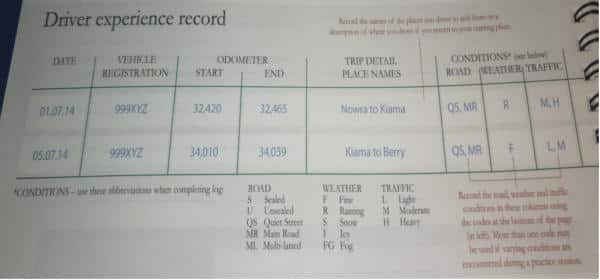Learner log book mistakes in NSW result in a lot test cancellations. As a driving instructor I spend a lot of time at the Roads & Maritime Services with my students who are doing driving tests. Because driving test centres run multiple driving tests simultaneously I get to see a lot of other learner drivers doing the test at the same time.
Learner drivers under 25 years old must present a completed log book to the testing officer. Who then checks the log book to make sure it is filled in correctly. Seeing an examiner refuse to do the driving test because a log book is incomplete was surprising at first, unfortunately it happens a lot. When I check my students log book it seems like a simply thing to do. Which makes it hard to believe how many students don’t even bother to check their log books. Here is a simple list to remind you to check your log book

Each time you go for a drive make sure you complete each column in the log book for that drive. Incomplete entries will not be included in your total driving hours. You must record
Make sure the hours spent driving between locations make sense and the kilometres travelled suit the time frame. Because I have seen a person who entered an average speed of 100 km per hour when their learner license has a maximum speed of 90 km/h. Obviously this did not work out for them. Therefore you need to check your entries to make sure they are valid and make sense. Finally don’t be lazy enter the details as you go, because leaving it till later usually leads to missing information or incomplete entries.
Take a driving lesson with Learn to drive and get your instructor to check your log book. To learn more about why you should take a lesson read our Better Way Training program Blog.
I often get phone calls from people who want driving lessons after they have failed the driving test. When I meet them for their first lesson their log books learning objectives have been signed. Which means their supervising driver taught them the learning objectives. So they should know what to do right? Then when I look at their test score sheet they failed for things covered in the learning objectives. Which seems strange that you would fail for things you already know how to do.
When I drive around with the learner and observe their driving it becomes obvious that they do not know how to do basic things covered in the learning goals in the log book. Sadly a lot of people simply sign the learning objectives. In fact a lot of learners tell me that they did not even read the learning objectives. Read the learning objectives then practice them and make sure you can actually do them.
You are given a bonus 20 log book hours for completing the Safer Drivers Course, there is a section in the log book for this. The Roads & Maritime Services want you to do the course, that is why they give you a 20 hour credit for completing the course. Because this course teaches you how to drive safely. Unfortunately a lot of students do not do the course. Then they fail for creating a dangerous situation or for doing something that required the testing officer to intervene. If only they did the course and learnt how to drive safely in the first place.
Your log book recognises the benefits of the Safer Driver Course and rewards you for completing the course. You learn things that will help you pass the driving test including:
Accruing 120 log book hours might seem challenging, but there are several proven strategies to effectively reach this target: Guided Driving: Opt for driving sessions under the watchful eye of someone possessing a full-fledged Australian licence. This person’s guidance can provide invaluable real-world exposure and experience.
Engage with a licenced driving instructor for structured and comprehensive driving lessons. They will not only contribute to your log book hours but also ensure a solid foundation in driving skills. Leverage 3-for-1 Driving Lessons: Benefit from the 3-for-1 driving lessons, a specific program where one hour of professional tuition equates to three log book hours, enabling a faster accumulation of required hours.
Attending a Safe Drivers Course not only enhances your understanding of safety rules and practical driving techniques but also adds valuable hours to your log book. Remember, the goal isn’t just about accumulating hours; it’s about becoming a safer, more competent driver.”